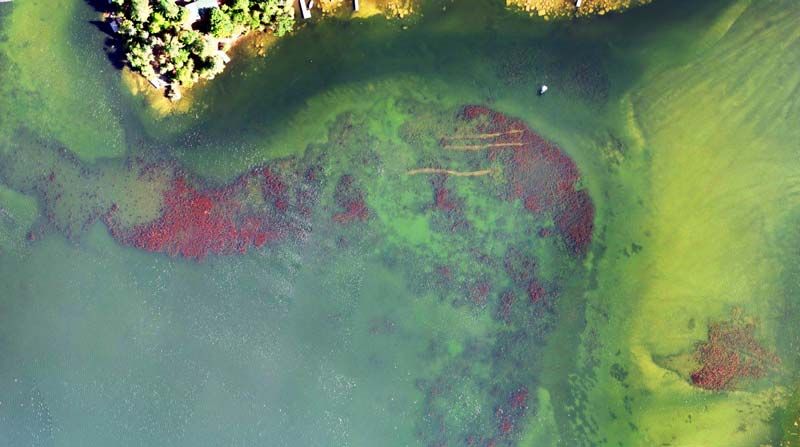Brenda Martin (with files from Jeff Green) | Aug 14, 2019
On August 6th, members of the North Frontenac community and beyond, gathered at Clar-Mill Hall in Plevna to partake in an education session hosted by MALLA (Malcolm Ardoch Lakes Landowners’ Association) regarding the t Eurasian Water Milfoil infestation which has negatively affected many lakes in the area.
The goal of the session was to inform community members on the precautions which are being taken to minimize the harsh effects this invasive plant is having on local aquatic ecosystems. Many local lakes sent representatives and multiple local organizations and businesses made an appearance as well some of which provided educational booths. Booths were provided by Kelly Stiles from Mississippi Valley Conservation Authority, Makayla Parks, the owner and operator of Highland Aerial Canada, Chole Lajoie from Watersheds Canada and Olivia from Federation of Ontario Cottage Associations.
The presentation provided the highlights of the MALLA Eurasian Water Milfoil Management plan thus far and provide an environment where audience members could share their experiences.
The main goal being - to gain some control over this invasive species.
The MALLA project features a unique partnership. North Frontenac Township who provided the initial funding in 2018 for the purchase of burlap mats, which is the latest method of controlling this invasive plant that is being deployed. In 2019, NF Township also funded a MALLA summer student with knowledge of drone operations; Ryleigh Rioux. The Above and Beyond class at Granite Ridge Education Centre is also a partner. They have provided the lake with aerial imagery of the recent infestation under the supervision of teacher Wade Leonard, who trains students in drone technologies. Two of these students are Ryleigh Rioux and Makayla Parks. The final partnership is with Professor Jessie Vermaire and grad student Patrick Beaupre from Carleton University who are well known for their studies in aquatic invasive species.
Ryleigh Rioux, the MALLA summer student, provided a detailed summary of the project thus far by supplying aerial maps from the last three years. She compared 2017, 2018, and 2019 data indicating the huge expansion of the EWM colonies across Malcolm and Ardoch Lakes.
“Over the last 8 months, there has been a dramatic increase in all the patch sizes, the most dramatic being the one at Ridge Lane, but there have also been significant increase in size of all the patches,” Rioux told the News in a phone interview afterwards.
That’s the bad news, but while there is not quite any good news there is some promising news.
“Last year, we laid our first sheet of burlap in the mouth of Ardoch Lake, and dozens of sheets were laid at the beginning of this summer, and the burlap has slowed the growth of the millfoil enough for the area to be safe for boating, and gives an opportunity for other treatments. There have also been good results from the introduction of the milfoil weevil. No treatment can eradicate the milfoil, but hopefully it can be contained,” she said
Rioux has conducted 7 drone flights over sections of the lake so far this summer as part of the project and 7 more are planned.
The drone flights are scheduled around a kind of goldilocks weather scenario (not too sunny because the images get washed out but not too much low cloud because the images can be too dark) as well as the availability of volunteers from the lake association. Because she is a licensed drone pilot, Rioux can operate the drone from one boat, and two to three other boats are also necessary so that someone can have eyes on the drone at all times.
“It takes a lot of organization to do the drone flights,” she said.
She has been using the Granite Ridge drones for the work until now, but going forward she will be using a new drone that she just purchased, equipment that may also help her to start up her own business in the coming months.
As the drone work has been proceeding, Jessie Vermaire and Patrick Beaupre from Carleton University have been collected data from the lake. They are looking at the impact of the milfoil on aquatic life in the region and will be monitoring the impact on aquatic life. They will also be looking at the impact of the milfoil mitigation efforts on aquatic life.
At the meeting in the Clar-Mil hall, the range of strategies that MALLA has selected to minimize the negative effects of milfoil on their lake system were discussed. The number one strategy is still hand pulling along shorelines, followed by the laying of biodegradable burlap mats, educating community members, lobbying for government funding, and the expanding a weed watch program.
The presentation was followed by an interactive question and answer session. Some discussion centred on the use of weed cutters both hand- held and motorized as a strategy of removal as well as the use of the Milfoil Weevil, which has had promising results in other lakes.
The day came to a close with the reading of “The Story of The Starfish” which highlights the importance of making a difference as we all have the ability to make a positive change to the environment- even if it is a small one.
More Stories
- The Sun Shines On The Parham Fair
- Creating Your Own Weather, Forever and Ever
- Silver Lake Pow Wow Set For A Big Year
- South Frontenac Receives Substantial Provincial Grant for their Verona Housing Project
- South Frontenac Council Report - August 12
- Dumping To Be Curtailed At Loughborough Waste Site
- Central Frontenac Inching Towards Increasing Severance Opportunities
- Addington Highlands Council Report - August 12
- Addington Highlands Council Report - August 5
- Addington Highlands Council Report - August 12

